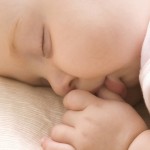How Much should a Newborn Baby Sleep ?
Sleeping Patterns In The Period Of Infancy
 In the first three to four weeks after birth, the infant sleeps frequently both during day as well as night. His only need is food (milk) so he wakes up just to get it. After the fourth week, his period of sleep increases but the frequency of sleeping decreases. In other words, he stays awake for longer time. One should not try to interfere with this sleep pattern or hamper it in any way. However, efforts should be made that the infant’s periods of sleep are regular. If this is not so the infant may sleep for almost the whole day and get much troubled during night. The child should be made to develop the habit of sleeping during or soon after afternoon, especially after the main meal of the day.
In the first three to four weeks after birth, the infant sleeps frequently both during day as well as night. His only need is food (milk) so he wakes up just to get it. After the fourth week, his period of sleep increases but the frequency of sleeping decreases. In other words, he stays awake for longer time. One should not try to interfere with this sleep pattern or hamper it in any way. However, efforts should be made that the infant’s periods of sleep are regular. If this is not so the infant may sleep for almost the whole day and get much troubled during night. The child should be made to develop the habit of sleeping during or soon after afternoon, especially after the main meal of the day.
How to Make Baby Sleep through the Night ?
An infant has low body temperature and its ability to produce heat is also very small. So, it’s imperative that an infant must sleep along with its parent in the beginning. If the child is not able to sleep soundly with his mother he should be made to sleep on a separate bed with another female. He however, should be brought to its mother in the wee hours before morning for milk. This is essential for mother’s health also.
After about six weeks, a healthy baby may be made to sleep in a cradle or a small bed. It should be insured that he is properly clothed and covered. The room should be maintained at a temperature of about 60 degrees Fahrenheit and the infant should not be exposed to any type of cold air. The above-mentioned precautions are necessary because the capacity of producing heat lessens during sleep. Frequent exposure to cold may lead to swelling of some interior organ of the body. Such cases are very difficult to diagnose.
However the face of the child should not be covered while sleeping, nor should he be heavily clothed, otherwise he may not get fresh air. For the same reason the room should not have a fireplace. It is advisable that up to two years a child should be made to sleep on a feather bed and its pillow should preferably be made of horsehair. This is done to keep his head at a lower temperature because it is also the time at which teething starts.
Sleeping Pattern During Childhood
It should be taken care of that the child sleeps about 1 hour before its dinnertime. This pattern may be discontinued gradually but the child must get a lot of sleep on an average, as childhood demands more sleep in comparison to adulthood. The child should be made to sleep between 7 and 8 in the evening and if possible not woken up until the next early morning. This is a symbol of good health. However, this rule cannot be generalized, as every child is a different child. Still, care should be taken that a child goes to sleep at a fixed time in the evening and is not disturbed as long as he sleeps.
Necessary amount of sleep varies according to age and habits. Infants sleep most of the time. Small children sleep for 12 to 14 hours. School-going children are asleep almost 10 hours and a youth sleeps about 8 hours a day. The adults may sleep for 4,5 or 6 hours in a day.
A mother crosses the limits of self-indulgence when she keeps her child awake for the sake of a party or other such function. A child needs proper sleep for its health more than people’s admiration and eulogizing. Such a child gets improper sleep and thus becomes a victim of lethargy and tiredness the following morning. Such incidents, if occur frequently may become severely detrimental for the child’s health.
When a child is awake, he should not be allowed to linger on in the bed. He should be persuaded to leave the bed straight away. This ensures good mental and physical health and even promotes longevity in the long run. A child should not be hurriedly aroused from sleep. This gives a shock to the brain and the heart, as they have to increase their functioning almost immediately. This if oft repeated might lead to dire consequences. Gradual wakefulness is always recommended.
At this stage, the child should not sleep on a feather bed but a mattress. This is because, a feather bed is so soft that the child sinks into the bed and thus gets an overdose of warmth. This is counter productive to child’s body, as the skin gets so much relaxed that it gets weakened. The child always remains in the danger of catching a cold soon. After the child vacates the bed, the bedclothes should be exposed to air, the mattress should be properly shaken and the ventilation of the room put to proper use. The child should preferably sleep alone and must not sleep with ill or extremely old persons at all.